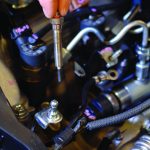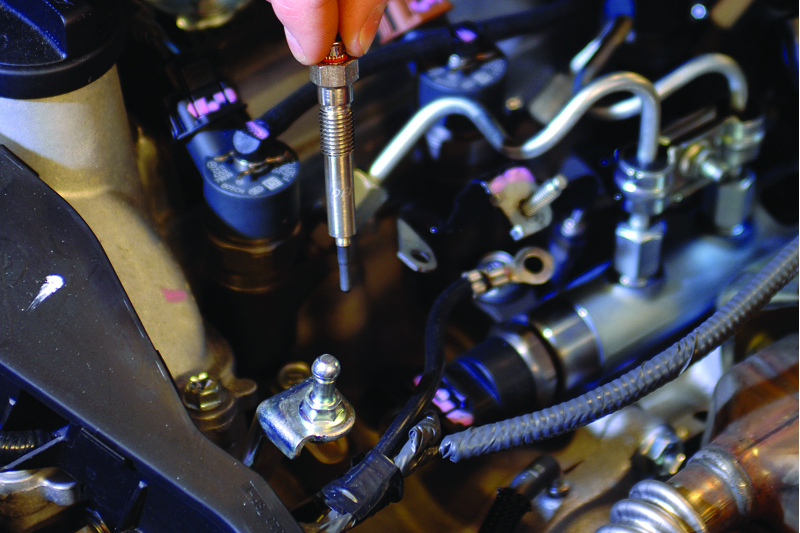A damaged or broken glow plug could spell disaster for a driver, causing a misfiring engine or, at worst, failure to start. To make life easier for garages and to keep customers on the road, DENSO has produced a diagnostic guide to help spot and fix common glow plug faults.
Enlarged probe tip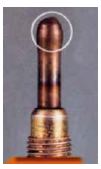
Causes: This is most often caused by excessive voltage being delivered through the glow plug, such as putting a 12V glow plug in a 24V system. It could also be the result of alternator and regulator failure. Storing a glow plug in a damp environment can also lead to a probe tip becoming enlarged.
Solution: Ensure you check that the glow plug voltage is correct. Also look over the charging system and ensure the glow plugs aren’t being stored in damp or wet conditions.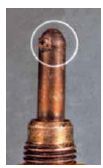
Broken probe tip
Causes: The causes of a broken probe tip may be similar to those of an enlarged tip, with excessive voltage being the most likely culprit.
Solution: Check the contact on the glow plug regulator. Also check the on-board and glow plug voltage. As with an enlarged tip, check the charging system voltage.
A swollen ring on the probe tip
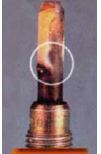 Cause: This is most likely caused by oil present in the combustion chamber, which is likely to be the result of engine wear.
Cause: This is most likely caused by oil present in the combustion chamber, which is likely to be the result of engine wear.
Solution: Make sure you check the piston clearance in engine cylinders and double- check the oil consumption levels. There may be an issue with the turbocharger seals, so ensure they are intact. Also look over the crankcase ventilation system.
Holes/cracks in the probe, or melting next to the body of the glow plug
Causes: There are a variety of factors which may lead to damage of the body of the glow plug, including a failure of the ignition unit and the direction of the regularity of the fuel jet being incorrect. It may also be the wrong spraying position caused by faulty sealing. Alternatively there may be a functioning or  timing fault in the injection unit. There may also be thread damage to the opening of the cylinder head. The glow plug may also be insufficiently tightened, which may cause the plug to sit incorrectly.
timing fault in the injection unit. There may also be thread damage to the opening of the cylinder head. The glow plug may also be insufficiently tightened, which may cause the plug to sit incorrectly.
Solution: Make sure you are using the correct ignition unit for the vehicle model and that the ignition unit is properly installed. Make sure that you have checked the glow plug installation for thread damage and carbon fouling. Check the opening of the cylinder head for thread damage or carbon residue. Ensure you check the timing of the injection pump and timing gear.
Carbon deposits between probe and the body of the glow plug
Causes: Often it is due to the failure of an ignition unit, or a direction or regularity of a fuel jet being incorrect. You may also have the wrong spraying position caused by faulty sealing. Alternatively there may be an injection pump operation or timing failure.
Solution: Check the correct ignition unit for the vehicle model is being used, and ensure it is correctly installed. Also look out for carbon deposits on the glow plug installation point. Inspect the opening of the cylinder head for thread damage/carbon fouling. Finally, measure the timing of the injection pump and ensure it’s correct.
Missing probe
Cause: The ignition unit may have failed, or the glow plug may be insufficiently tightened, which may cause the plug to sit incorrectly. Alternatively, the direction or regularity of a fuel jet may be incorrect. A wrong spraying position could also be caused by faulty sealing. A missing probe may also be a sign that the injectors are damaged. Lastly, check that there isn’t thread damage to the opening of the cylinder head.
Solution: Ensure there is no thread damage or carbon fouling to the glow plug installation point. Check the timing of the injection pump and ensure the opening of the cylinder head for thread damage/carbon fouling.
Broken/bent power terminal
Causes: Excessive torque or the use of the wrong tool. It may also be due to thread damage to the opening of the cylinder head.
Solution: Be sure to check the opening of the cylinder head for thread damage and carbon fouling. Also double check the glow plug torque is correct.

